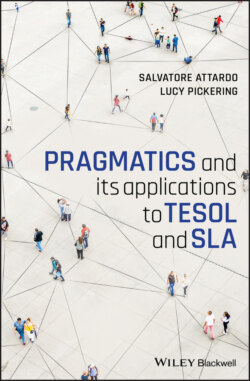Читать книгу Pragmatics and its Applications to TESOL and SLA - Salvatore Attardo - Страница 36
3.1.2 Speech Acts, Searle
ОглавлениеThe idea of speech acts was taken up by John Searle, who combines it with Wittgestein’s idea of “rule following.” The canonical presentation of speech act theory is Searle (1969). For Searle, speaking a language is following its rules (1969, p. 12). These rules are conventional (1969, p. 37), which makes them constitutive (1969, p. 36), that is, the activity does not exist outside of the conventional rules (compare playing chess, where the rules are constitutive, with running, where one runs even if one runs regardless of the rules of running competitions). Institutional facts are events that are based on constitutive rules. So, winning a hand at poker is based on and/or makes sense only within the context of the following of the institutional facts, that is, the constitutive rules of poker. If the game of poker did not exist, having four cards that are the same, but in different suits would be meaningless. Significantly, the rules of language are institutional facts (1969, pp. 51–53).
Along the lines of Austin, Searle distinguishes several acts within a speech act. The general form of a speech act is F (p), where F is the illocutionary force of the act and p is the proposition expressed by the speech act. In other words, a speech act consists of at least two separate acts: uttering a proposition and doing so with a given illocutionary force.
Searle lists five types of illocutionary forces; Table 3.1 lists their formal representation (1969, p. 31).
Thus, I promise I will come and I will come express the same proposition, but differ in illocutionary force, being a promise and an assertion, respectively. Let us consider a different example: take the sentence below followed by its logical representation
Table 3.1 Speech acts and their formal representation, according to Searle (1969).
| 1. | assertions | (p) |
| 2. | requests | ! (p) |
| 3. | promises | Pr (p) |
| 4. | warnings | W (p) |
| 5. | yes-no questions | ? (p) |
(10) The book is on the table.
p = ON(book, table)
The proposition expressed by this sentence is roughly that there is a property of being on something and that a book has that property and the something it is on is a table. When someone says The book is on the table they are asserting this proposition, or
˫(p) (recall that p stands for ON(book, table))
however, let’s assume that we don’t know whether it is the case that the book is on the table, we may ask about it, by saying Is the book on the table? which corresponds to
?(p)
or we may want the book to be on the table, and so we request that it be so, perhaps by saying Let the book be on the table, albeit usually people use polite variants of this, such as please, could the book be on the table, which corresponds in Searle’s notation as our (p) proposition with the force of a request:
! (p)
Likewise, we can utter (p) with the force of a promise or a warning: the book will be on the table (if you do something I want), which corresponds to
Pr(p)
or The book better be on the table (or I will do something you do not want), that is,
W(p)
In other words, the force changes with each illocution, but the proposition remains the same.
Searle categorizes speech acts into five large groups,3 which constitute the kinds of things one can “do with words” or “ways of using language” (Searle, 1979, p. vii)
1 assertives or representatives (assertions, claims and reports, …)
2 directives (requests, suggestions, commands, …)
3 expressives (thanks, apologies, complaints, …)
4 commissives (promises, refusals)
5 declaratives (performatives: the act of speaking itself performs the act: I sentence you to life in prison; Class dismissed).
(Searle, 1979, pp. 12–19). Thus, Searle directly counters Wittgenstein’s claim that there are countless kinds of language games, by reducing them to five very abstract types.
